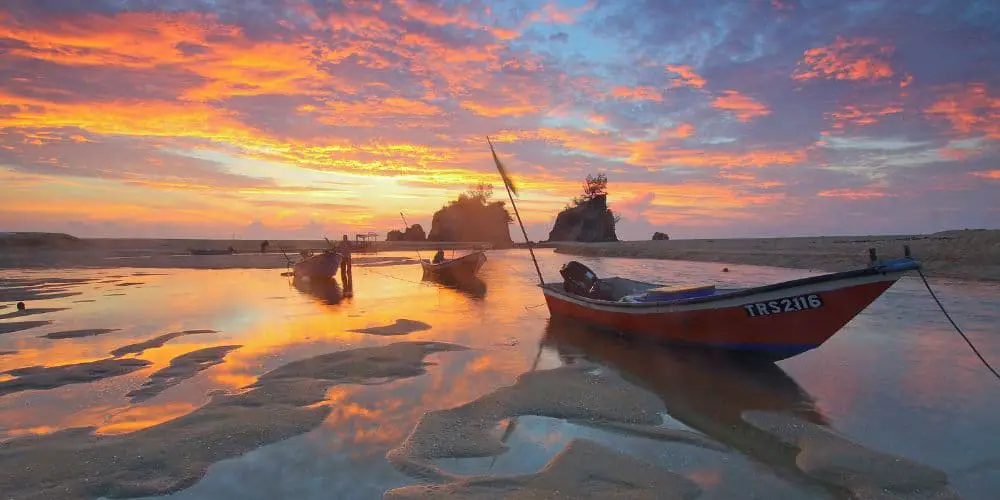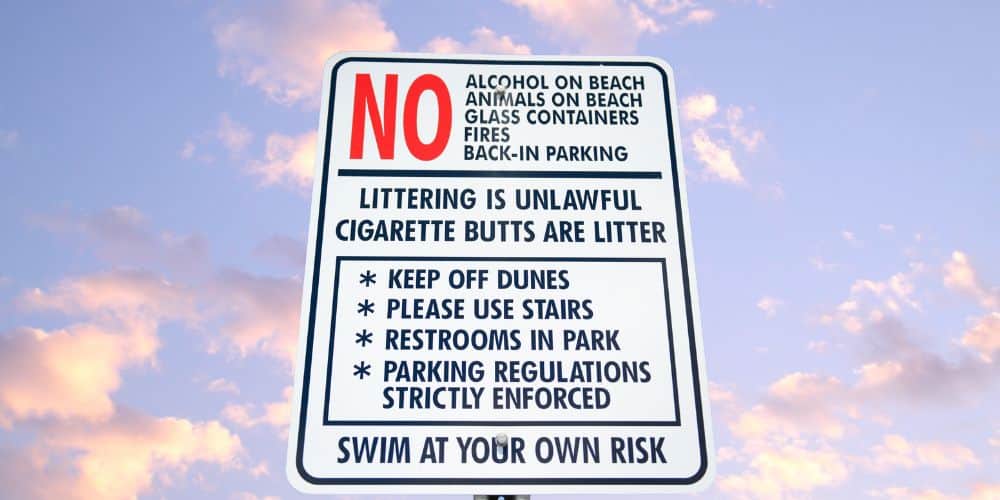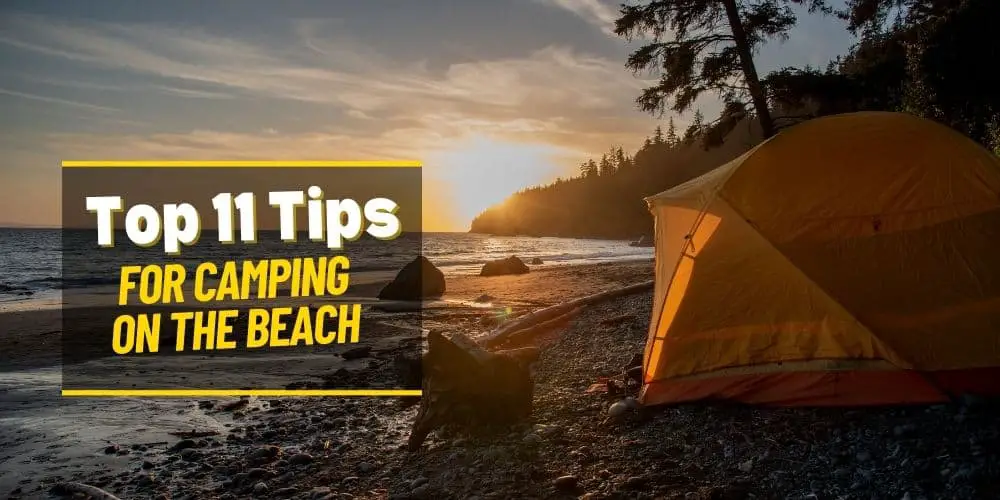Top 11 Tips for Camping On the Beach
What is it about camping on the beach that captures the imagination of so many people?
If you ask outdoors people where their dream place to camp is, you will get two main answers: Mountains and the ocean. The main reason they give is the same. To be surrounded by a majesty that is much bigger than we are. Add to this the fun of a sandy beach, and you have a recipe for a great trip.
Since the surface of the Earth is more than 70% water, finding beaches to camp along is plentiful in most countries. In the United States, you will find thousands of miles of Atlantic and Pacific coasts and the Gulf of Mexico. Plus, the Great Lakes bordering Canada have many more miles of beaches.
Camping on the beach is one of the most excellent experiences you can have, but it comes with some unique challenges you might not have thought of. The sand, water, and lack of shade will all have an effect on your camping experience, and you will need to make sure you are prepared to meet these challenges if you want to have a good time.
Table of Contents
- Know The Tides
- Beware Of The Wind
- Get Tent Pegs for Sand or Snow
- Learn The Rules
- Pick Your Spot
- Do Some Landscaping
- Plan To Clean
- Always Wear Sun Protection
- Bring A Tarp Or Sunshade
- Wear Polarized Sunglasses
- How To Make A Fire
- Conclusion
Know The Tides
Whether on a lake or the ocean, it is important to know where the high water line is and camp above it. The last thing you want to happen is to set up your tent and have the waves wake you in the middle of the night when they come crashing over your sleeping bag. Not only does getting your gear wet suck, but the salt water is hard on most equipment.
Research the times of high and low tide before you head out to the beach so you know when to expect the water to come in. If you hit the beach before high tide, look for the line of seaweed and driftwood that will delineate the high water mark. Aim to set up at least 50 feet from the high tide level.
When camping on a beach on a freshwater lake, the daily variation isn’t usually as much as the ocean, but heavy rains can cause a rapid rise in the water level. Windy conditions can also increase the distance the waves come ashore. There will usually be a line of washed-up materials that show the distance the waves come in. It is recommended to set up at least 50 feet back from this line to give yourself plenty of safety margin for heavy rains and high winds.

Beware Of The Wind
With the combination of open water and no tree cover, you will usually be facing windier conditions on a beach compared to forested camping. This necessitates securing your equipment more thoroughly and making adjustments when it comes to tasks like cooking.
You can’t just spread your gear around as you are setting up, as light items will often end up flying down the beach. I’ve watched people’s tents, hats, and maps all blow away while they comically chase after them.
Make sure tents are pegged down and weighted. Any light items should be secured by attaching them to something too heavy to blow away or putting something heavier on top of them.
When cooking, you will need to create a wind break so your stove won’t blow out. This might mean moving back to the forest at the beach’s edge to cook or build a wind block from packs or driftwood to protect your stove.
Get Tent Pegs for Sand or Snow
Unlike the packed dirt of many forest campsites, sand doesn’t have very good holding power when it comes to regular tent pegs. Due to the increased wind exposure you will find on a beach, it is imperative to secure your tent so it doesn’t blow away.
When camping on the beach, you should bring a small shovel and broad-bladed tent pegs designed for sand or snow. You will often have to dig down to bury these pegs, so they are in damp sand, which is much denser. This increases the load that the pegs will hold. This type of peg will often have a steel wire attached to it that will extend out of the sand to connect your tent.
While you might only need to peg down the corners and vestibule when camping on hard dirt, on the beach, we recommend running some extra guylines for extra stability. This usually works out to needing 8-10 tent pegs designed for soft surfaces.
When looking for heavy-duty tent pegs for windy conditions, read our round-up of tent pegs for windy conditions.
Learn The Rules
Before heading out to camp on a specific beach, it is smart to research what the rules are. Many beaches don’t allow camping, and if you get caught, you could face a hefty fine. If a given beach allows camping, then learn if there are any rules and make sure to follow them, so you don’t get in trouble and don’t risk losing access in the future.
And regardless of any specific rules, always follow the Leave No Trace principles. Carry out all garbage and bury human waste at least 300 feet from any trail or water source.

Pick Your Spot
Beaches all slope towards the water, so it pays to take a bit of time to find the flattest spot you can, at least 50 feet back from the high water line. Position your tent so that your head is at the high end, as sleeping the other way will find you waking up with a pounding headache.
You might want to set up with the door of your tent facing the water so you get a nice view, but if that means you are lying sideways to the slope, you will be uncomfortable as you will feel like you are rolling downhill the whole time.
To better understand how to make the best use of your tent, check out our article on tent anatomy.
If you can find a spot that is sheltered on at least one side by sand dunes or driftwood, you will be subject to less wind which can help with cooking and keeping your camp clean.

Do Some Landscaping
Before setting up your tent, it is a good idea to smooth the sand. You can improvise tools with driftwood or brush from a nearby forest. Fill in any ruts or holes. When moving the sand, try to draw it towards the water, as this can help level out your campsite.
With plenty of larger driftwood around, you can build a raised campsite with logs. Half bury the logs in a square shape and then fill in with sand. The logs will keep the sand from shifting and gives you a bit more water clearance in case of rain.
Plan To Clean
While camping on the beach comes with the beauty of the lapping waves and amazing sunsets, it also comes with wind and sand. That combination means that sands will get in everything, including your tent.
When camping on the beach, it is smart to bring a small hand broom and dustpan to clean your tent out because no matter how careful you are, you will bring sand into the tent. The broom can also be used to brush the sand off of your feet and other items.
Leave the rain fly on your tent during the day because if you remove it, you will find even more sand that will make its way into your tent.
Each day take out your sleeping bag and sleeping pad to brush or shake the sand off of them.
Always Wear Sun Protection
Whether you slather yourself in sunscreen or wear long sleeves and a hat, you must protect yourself from the sun when spending extended time on the beach. For most people who don’t get a lot of sun exposure, you can burn in as little as 30 minutes. When on the water, you are faced with both direct sun and the reflection off the water, so don’t take sun protection lightly.

Bring A Tarp Or Sunshade
The openness of the beach is an attraction, but it is also a curse because unless you are beach camping during overcast days, you will be faced with unrelenting sun exposure. If the temperatures are hot, you can’t use your tent to escape the sun as it will be too hot.
A portable sunshade or tarp and poles are required on a sunny beach to avoid sunstroke and sunburns. Also, ensure you bring a collection of extra pegs that will work well in the sand for the sun shelter, as you don’t want to chase it down the beach.
Wear Polarized Sunglasses
To cut the reflected glare off the water, bring a pair of polarized sunglasses. The lens coating of these glasses makes the sun reflecting off the water vanish. This is good for both your eyes, and it makes it possible to see in the water if you are fishing.
How To Make A Fire
Nothing tops out a summer night like a campfire on the beach, but like all beach camping experiences, there are some unique challenges that you will have to deal with.
Many beaches are awash with driftwood that is well-aged and dry. This makes for great firewood, but you are also in a very windy environment, so some planning is in order if you want to have a successful campfire on the beach.
To protect from the wind, you should dig a pit 8-12 inches deep to give some protection from the wind. Ensure it is above the waterline as you still want it to be relatively dry sand you are starting your fire on.
Lay a base of dry wood at the bottom of the pit to keep the fire off of the damp sand until it is well established. For more tips on fire making, our article on keeping a fire going all night can help you out.
Bring a folding pruning saw to process the wood you collect, so it fits in your firepit.
Once you are done with the fire, douse it with water and bury the remnants with sand.

Conclusion
Camping on the beach can be a lot of fun, but you need to prepare differently than camping on grass or in the forest. The beach has its beauty and pitfalls compared to other campsites, and with some planning, you can have a great time.
Just remember that sand gets everywhere, so you will pick it out of your gear and yourself for days after camping on the beach, but that little inconvenience is worth the idyllic setting of beautiful sunsets or sun rises and the lapping of waves on the shore.

